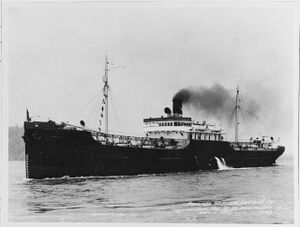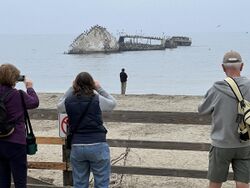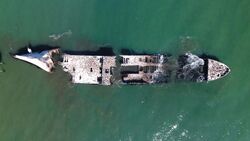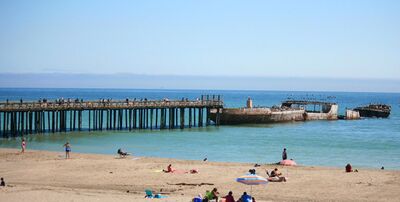Engineering:SS Palo Alto
 Palo Alto on sea trials, on 10 September 1920.
(Naval History and Heritage Command - Photo NH 799) | |
| History | |
|---|---|
| Name: | SS Palo Alto |
| Namesake: | Palo Alto, California |
| Builder: | San Francisco Shipbuilding Company, Oakland, California |
| Launched: | 29 May 1919 |
| Fate: | Grounded as a fishing pier at Seacliff Beach in Aptos, California |
| General characteristics [1] | |
| Type: | Design 1100 tanker |
| Length: | 420 ft (130 m) |
| Beam: | 54 ft (16 m) |
| Depth: | 35 ft (11 m) |
| Propulsion: |
|
SS Palo Alto was a concrete ship built as a tanker at the end of World War I. Completed too late to see war service, she was mothballed until 1929, when she was intentionally grounded off Seacliff State Beach in the Monterey Bay, becoming part of a pleasure pier entertainment complex. Palo Alto was damaged by the sea, leading her to be stripped and used only as a fishing pier. Subsequent decades have seen her be further broken by the sea, but large sections of her wreck remain somewhat intact.
History
SS Palo Alto was built by the San Francisco Shipbuilding Company at the U.S. Naval Shipyard in Oakland, California. She was launched on 29 May 1919, too late to see service in the war.[2] Her sister ship was the SS Peralta.
Palo Alto was mothballed in Oakland until 1929, when she was bought by the Seacliff Amusement Corporation and towed to Seacliff State Beach in Aptos, California.[3] A pier was built leading to the ship in 1930,[4] and she was sunk in a few feet in the water so that her keel rested on the bottom. There she was refitted as an amusement ship, with amenities including a dance floor, a swimming pool and a café.[5]
The company went bankrupt two years later during the Great Depression, and the ship cracked at the midsection during a winter storm. The State of California purchased the ship,[4] and she was stripped of her fittings and left as a fishing pier. She was a popular site for recreational fishing,[4] but eventually she deteriorated to the point where she was unsafe for this purpose, and she was closed to the public in 1950.[4] Following an attempt at restoration in the 1980s, she reopened for fishing for a few years, then closed again. The fishing pier opened to foot traffic once again in the summer of 2016, but later closed for repairs.[6]
Nicknamed the "Cement Ship",[7] Palo Alto serves as an artificial reef for marine life. Pelicans and other seabirds perch on the wreck,[4] sea perch and other fish feed on algae that grow in the shelter of the wreck,[4] and sea lions and other marine mammals visit the wreck to feed on the fish.[4]
In the spring of 2005, oil found on wildlife nearly two years earlier, killing dozens of seabirds, was traced back to the ship, whose fuel tanks had cracked and were leaking fuel oil.[4] In September 2006, a clean-up project was started that cost an estimated $1.7 million,[4] approximately the same as the estimated $1.5 million cost of the original construction of the ship in 1919.[8] During the clean-up, workers pumped 500 U.S. gallons (416 Imperial gallons; 1,893 liters) of oil from the ship and discovered the carcasses of 200 more birds and two harbor seals inside the wreck.[4]
The ship continued to deteriorate after the clean-up.[4] While she had over the decades been broken into four roughly segmented pieces, winter storms in February 2016 pushed the wreck onto her starboard side and broke her rear half open.[4] On 21 January 2017, another winter storm tore the stern off the ship.[9][4] On 5 January 2023, yet another winter storm destroyed portions of the pier leading to the ship.[10]
See also
References
- ↑ Bender, Rob. "S.S. Palo Alto". concreteships.org. http://www.concreteships.org/ships/ww1/paloalto/.
- ↑ Heron, David W. (2002). Forever Facing South, The story of the S.S. Palo Alto "The Old Cement Ship" of Seacliff Beach. Santa Cruz, California: Otter B Books. ISBN 0-9617681-3-4. https://archive.org/details/ForeverFacingSouth/.
- ↑ "Sandy Lydon's Central Coast Secrets - Hooey History". sandylydon.com. http://www.sandylydon.com/hoo_1.html.
- ↑ 4.00 4.01 4.02 4.03 4.04 4.05 4.06 4.07 4.08 4.09 4.10 4.11 4.12 Guarino, Ben (January 23, 2017). "Historic concrete ship S.S. Palo Alto smashed in half by record Calif. storm waves". Washington Post. http://www.washingtonpost.com/news/morning-mix/wp/2017/01/23/historic-concrete-ship-s-s-palo-alto-smashed-in-half-by-record-calif-storm-waves/.
- ↑ deepgreen.com Seacliff State Beach USS Palo Alto
- ↑ Gibson, Ross Eric (January 22, 2023). "The history of Seacliff's Cement Ship" (in en-US). Santa Cruz Sentinel. https://www.santacruzsentinel.com/2023/01/22/the-history-of-seacliffs-cement-ship-ross-eric-gibson-local-history.
- ↑ Matthew Renda (29 May 2019). "'Cement ship' (SS Palo Alto) reaches a century". Santa Cruz Sentinel. https://www.mercurynews.com/2019/05/29/ss-palo-alto-reaches-a-century-a-little-worse-for-wear/.
- ↑ Williams, Fleur (January 29, 2017). "Template:Title case". http://localsantacruz.com/history/history-seacliff-beach-cement-ship/.
- ↑ "Cement Ship in Santa Cruz County torn apart by massive waves". San Jose Mercury News. 22 January 2017. http://www.mercurynews.com/2017/01/22/historic-cement-ship-in-aptos-torn-apart-by-massive-waves/.
- ↑ Regimbal, Alec (2023-01-05). "Dock to Santa Cruz 'cement ship' destroyed amid storm waves" (in en-US). SFGate. https://www.sfgate.com/bayarea/article/santa-cruz-cement-ship-breaks-17697089.php.
External links
[ ⚑ ] 36°58′10.75″N 121°54′50.31″W / 36.9696528°N 121.913975°W
 |






